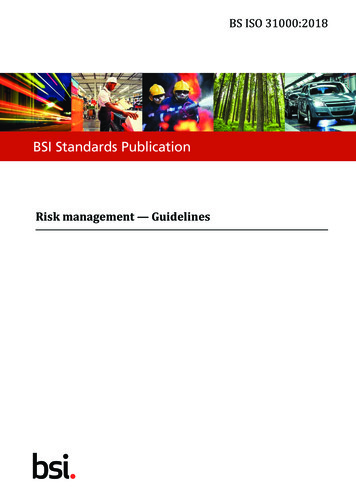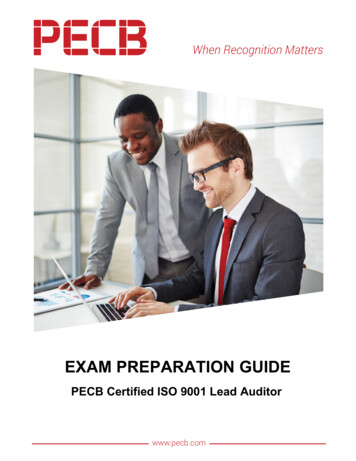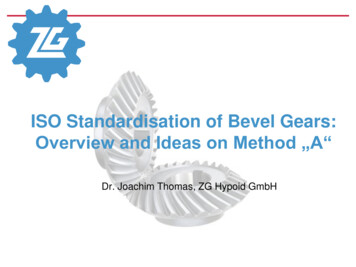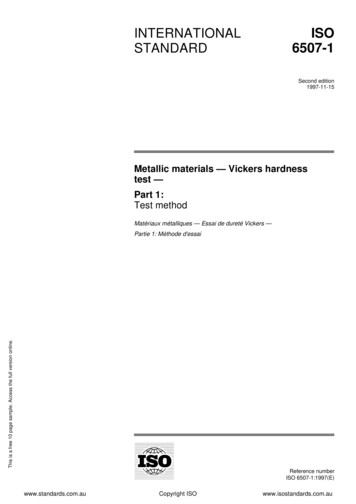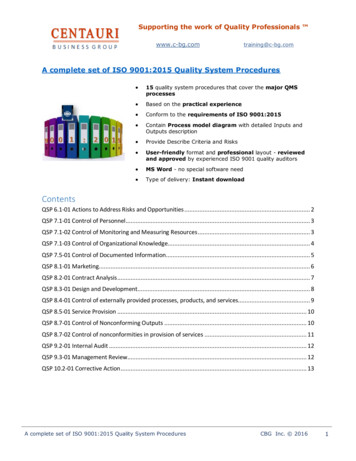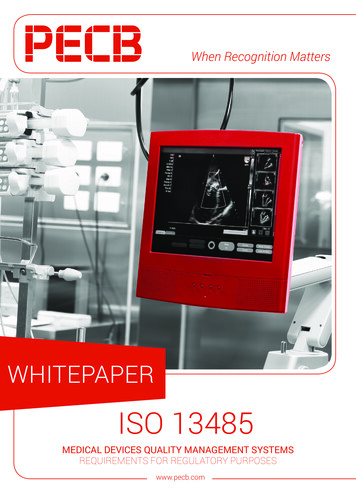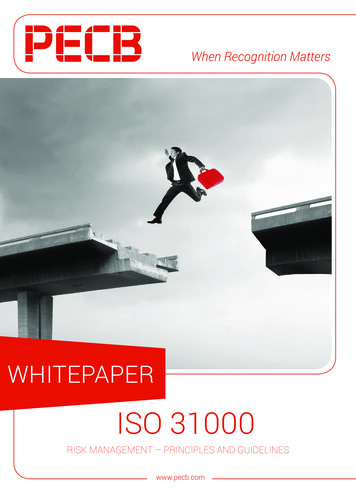
Transcription
When Recognition MattersWHITEPAPERISO 31000RISK MANAGEMENT – PRINCIPLES AND GUIDELINESwww.pecb.com
CONTENT3Introduction4An overview of ISO 31000:20094Structure of ISO 31000:20095Key clauses of ISO 31000:20097Link between iso 31000 and other standards7Link with ISO 270057Risk Management – The Business Benefits7Implementation of Risk Management with PECB Risk Management Framework8Training and certification of professionalsPRINCIPAL AUTHORSEric LACHAPELLE, PECBBesnik HUNDOZI, PECB2ISO 31000 // RISK MANAGEMENT – PRINCIPLES AND GUIDELINES
INTRODUCTIONISO 31000 is an international standard issued in 2009 by ISO (International Organization for Standardization),and it is intended to serve as a guide for the design, implementation and maintenance of risk management.All types and sizes of organizations face internal and external factors and influences that make it uncertainwhether and when they will achieve their objectives. The effect this uncertainty has on an organization’sobjectives is risk.Risk is involved in any activity of an organization. ISO 31000:2009 describes a systematic and logicalprocess, during which organizations manage risk by identifying it, analyzing and then evaluating whetherthe risk should be modified by risk treatment in order to satisfy their risk criteria.Risk management can be applied to an entire organization, at its many areas and levels, at any time, as wellas to specific functions, projects and activities.RISK – Effect of uncertainty on objectives1. Positive viewPotential gain2. Neutral viewProbability of eventsRISK3. Negative viewHarmful eventISO 31000 // RISK MANAGEMENT – PRINCIPLES AND GUIDELINES3
AN OVERVIEW OF ISO 31000:2009ISO 31000 provides principles and generic guidelines to assist organizations in establishing, implementing,operating, maintaining and continually improving their risk management framework.It is not specific to any industry or sector, so it can be used by any public, private or community enterprise,association, group or individual. This standard can be applied throughout the life of an organization, andto a wide range of activities, including strategies and decisions, operations, processes, functions, projects,products, services and assets.This standard is not intended to promote uniformity of risk management across organizations. Thedesign and implementation of risk management plans and frameworks will need to take into account thevarying needs of a specific organization, its particular objectives, context, structure, operations, processes,functions, projects, products, services, or assets and specific practices employed.WHAT IS RISK MANAGEMENT?Risk management is defined as a set of coordinated activities to direct and control an organization withregard to risk.STRUCTURE OF ISO 31000This figure shows the relationships between the risk management principles, framework and process.Risk assessmentPrinciples (clause3)4Mandate andcommitment (4.2)Continualimprovementof k identification(5.4.2)Risk analysis(5.4.3)Risk evalution(5.4.4)Monitoring andriview of theframework (4.5)Risk treatment(5.5)Framework (clause 4)Process (clause 5)ISO 31000 // RISK MANAGEMENT – PRINCIPLES AND GUIDELINESMonitoring and review (5.6)Design offramework formanaging risk(4.3)Establishing thecontext (5.3)Communication and consultion (52)a) Creates and protectscalueb) Integral part oforganizational processesc) Part of decision makringd) Explicitly addressesuncertaingye) Systematic, structuredand timelyf) Based on the bestavailable informationg) Tailoredh) Take human and culturalfactors into accounti) Transparent and inclusivej) Dynamic, iterative nadresoinsive to changek) Facilitates continualimprovement andenhancement of theorganaization
KEY CLAUSES OF ISO 31000:2009ISO 31000 is organized into the following main clauses:Clause 3: PrinciplesClause 4: FrameworkClause 5: ProcessEach of these key activities is listed below.CLAUSE 3: PRINCIPLES OF RISK MANAGEMENTIn order to have an effective risk management, an organization has to comply with these 11 principles.1. Risk management creates and protects value;2. Risk management is an integral part of all organizational processes;3. Risk management is part of decision making;4. Risk management explicitly addresses uncertainty;5. Risk management is systematic, structured and timely;6. Risk management is based on the best available information;7. Risk management is tailored;8. Risk management takes human and cultural factors into account;9. Risk management is transparent and inclusive;10. Risk management is dynamic, iterative and responsive to change;11. Risk management facilitates continual improvement of the organization.ISO 31000 // RISK MANAGEMENT – PRINCIPLES AND GUIDELINES5
CLAUSE 4: FRAMEWORKISO 31000 states that the success of risk management will depend on the effectiveness of the managementframework providing the foundations and arrangements what will embed it throughout the organization atall levels.The framework: assists in managing risks effectively through the application of the risk management process; ensures that information about risk derived from the risk management process is adequately reported; and ensures that these information is used as a basis for decision making and accountability at all relevantorganizational levels.This clause describes the necessary components of the framework for managing risk and the way in whichthey interrelate in an iterative manner.Mandate and commitment: Management of the organization needs to demonstrate a strong andsustained commitment to risk management by defining risk management policy, objectives, ensuring legaland regulatory compliance, ensuring necessary resources are allocated to risk management, communicatingthe benefits of risk management to all stakeholders.Design of framework for managing risk: Before the implementation, the organization must design aframework for managing risk. This includes: Understanding of the organization and its context Establishing risk management policy Ensuring accountability, authority and appropriate competence for risk management Integrating risk management into organizational processes Allocating appropriate resources Establishing internal and external communication and reporting mechanismsImplementing risk management: The organization must implement the framework for managing riskand risk management process.Monitoring and review of the framework: To ensure effectiveness of the risk management theorganization should measure risk management performance and progress, review whether the riskmanagement framework, policy and plan are still appropriate and review the effectiveness of the riskmanagement framework.Continual improvement of the framework: Based on results of monitoring and review, decisionsshould be made on how the risk management framework, policy and plan can be improved.Risk assessment: Risk assessment is the overall process of risk identification, analysis and evaluation. Risk identification: Through applying risk identification tools and techniques, the organizationshould identify risk sources, areas of impacts, events and causes, and their potentialconsequences. Risk analysis: Risk analysis involves the development of understanding of the risk, considerationof the causes and risk sources, their positive and negative consequences, the likelihood thatthose consequences can occur, provides an input to risk evaluation and decision whether risksneed to be treated, and on the most appropriate risk treatment strategies and methods. Risk evaluation: The purpose of this step is to assist in decision making about which risks needtreatment and priority for treatment implementation.Risk treatment: Risk treatment options should be selected based on the outcome of the riskassessment, the expected cost for implementing and benefiting from these options.6ISO 31000 // RISK MANAGEMENT – PRINCIPLES AND GUIDELINES
Monitoring and review: Monitoring and review can be periodic or ad hoc, and should be a plannedpart of the risk management process.Recording the risk management process: Risk management activities should be traceable. In therisk management process, records provide the foundation for improvement in methods and tool, as well asin the overall process.CLAUSE 5: PROCESSISO 31000 states that the success of risk management will depend on the effectiveness of the management The risk management process should be: An integral part of management; Embedded in the culture and practices; Tailored to the business processes of the organization. Risk management process comprises the following activities:Communication and consultation: Communication and consultation with external and internalstakeholders should take place during all stages of the risk management process.Establishing the context: By establishing the context, the organization articulates its objectives,defines the external and internal parameters to be taken into account when managing risk, and sets thescope and risk criteria for the remaining process.LINK BETWEEN ISO 31000 AND OTHER STANDARDSISO 31000 can be easily linked with other Risk Management standards, like ISO Guide 73:2009 – Riskmanagement vocabulary, and ISO/IEC 31010:2009 – Risk management – Risk assessment techniques.ISO/IEC 31010 is a supporting standard for ISO 31000 and provides guidance on selection and applicationof systematic techniques for risk assessment.LINK WITH ISO 27005Based on the ISO 31000 framework, the ISO 27005 standard explains in detail how to conduct a riskassessment and a risk treatment, within the context of information security.RISK MANAGEMENT – THE BUSINESS BENEFITSAs with all major undertakings within an organization, it is essential to gain the backing and sponsorship ofexecutive management. By far the best way to achieve this, rather than through highlighting the negativeaspects of not having risk management, is to illustrate the positive gains of having an effective riskmanagement framework in place.Risk management allows an organization to ensure that it knows and understands the risks it faces. Theadoption of an effective risk management process within an organization will have benefits in a number ofareas, examples of which include: Increased likelihood of achieving objectives Encouraged proactive management Awareness of the need to identify and treat risk throughout the organization Improved identification of opportunities and threats Compliance with relevant legal and regulatory requirements and international norms Improved mandatory and voluntary reporting Improved governance Improved stakeholder confidence and trust Establishment of a reliable basis for decision making and planning Improved controls Effective allocation and use of resources for risk treatmentISO 31000 // RISK MANAGEMENT – PRINCIPLES AND GUIDELINES7
Risk Assessment2. Context Establishment1. Risk ManagementFramework3. RiskIdentification4. RiskAnalysis5. RiskEvaluation4.1. Assessmentofconsequences3.1.Identificationof sources ofrisk, events andconsequences4.2. Assessmentof incidentlikelihood6. RiskTreatment6.1Risk treatmentoptions5.1Evaluation oflevels of riskbased on riskevalution criteria4.3. Level or riskdetermination6.2Risk treatmentplan6.3Evaluation ofresidual risk7. Risk Communication and Consultation8. Risk Monitoring and ReviewIMPLEMENTATION OF RISK MANAGEMENT WITH PECB RISK MANAGEMENT FRAMEWORKMaking the decision to implement a risk management framework based on ISO 31000 is often a very simpleone, as the benefits are well documented. By following a structured and effective methodology, an organizationcan be sure to cover all minimum practices required for the implementation of risk management programme.There is no single blueprint for implementing ISO 31000 that will work for every company, but there aresome common steps that will allow you to balance the often conflicting requirements and prepare you fora successful certification audit.PECB has developed a framework for risk management. It is called “PECB Risk Management Framework”and is based on applicable best practices.TRAINING AND CERTIFICATION OF PROFESSIONALSPECB has created a recommended training roadmap and a number of personnel certification schemes formanagers of an organization that wishes to demonstrate compliance to ISO 31000. Although ISO 31000is not intended to be used as a basis for certification of organizations, some of them are practicing it asit provides evidence that they developed standardized processes based on best practices. Certification ofindividuals serves as a documented evidence of professional competencies and experience for/of thoseindividuals that has previously attended the related courses and exam.8ISO 31000 // RISK MANAGEMENT – PRINCIPLES AND GUIDELINES
It serves to demonstrate that the certified professional holds defined competencies based on bestpractices. It also allows organizations to make an informed selection of employees or services based onthe competencies that are represented by the certification designation. Finally, it provides incentives tothe professional to constantly improve his/her skills and knowledge and serves as a tool for employers toensure that training and awareness have been effective.PECB training courses are offered globally through a network of authorized training providers and they areavailable in several languages. The table below gives a short description on PECB’s official training coursesfor risk management based on ISO 31000.Training titleShort descriptionWho should attend? ISO 31000 Introduction One day trainingIntroduction to concepts ofrisk managementDoes not lead to certification ISO 31000 Risk Manager Three day trainingManage the implementationand management of risk management framework2 hour exam Practitioners wanting tounderstand ISO 31000 andgain a deeper knowledge of therisk management processes asdescribed in the internationalstandardStaff involved in any stage ofrisk management programRisk managersBusiness Process OwnersBusiness Finance ManagersBusiness Risk ManagersRegulatory ComplianceManagersProject ManagementCHOOSING THE RIGHT CERTIFICATION:The certified ISO 31000 Risk Manager credential is a professional certification for professionals needing todemonstrate the competence to implement, maintain and manage a risk management program accordingto ISO 31000.CredentialExamProfessional experienceRisk assessmentexperienceProvisionalRisk ManagerCertified ISO 31000 RiskManager ExamNoneNoneRisk ManagerCertified ISO 31000 RiskManager ExamTwo yearsOne year of riskmanagement relatedwork experienceRisk managementactivities totaling 200hoursISO 31000 // RISK MANAGEMENT – PRINCIPLES AND GUIDELINES9
1-844-426-7322customer@pecb.comCustomer Servicewww.pecb.com
ISO 31000 can be easily linked with other Risk Management standards, like ISO Guide 73:2009 – Risk management vocabulary, and ISO/IEC 31010:2009 – Risk management – Risk assessment techniques. ISO/IEC 31010 is a supporting standard for ISO 31000 and provides guidance on selection and




